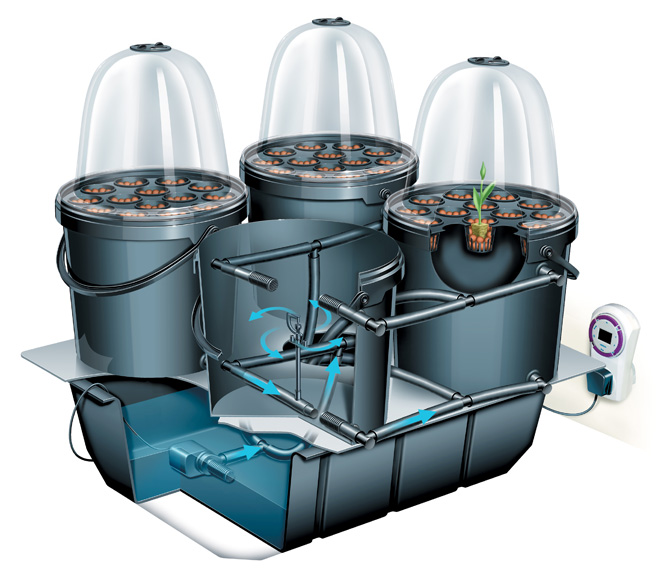
 |
|
Hydroponics - Indoor HorticultureHydroponics - Indoor Horticulture represents an educational, in-depth,
up-to-date,
indoor horticultural growers guide that covers all principles of indoor Hydroponics - Indoor Horticulture examines, explores, dissects and
presents a fully comprehensive step by step growers guide, relating
to all and every aspect of indoor hydroponic horticulture, with complete
chapters on plant biology, propagation, hydroponic systems, nutrients,
oxygen, carbon dioxide enrichment, pH, biological pest control, fungi/disease,
cuttings/clones, pruning/training, breeding, harvesting, equipment,
grow rooms, a full history of hydroponics, and more. |
(Below follows a one page sample taken from the
book)Taking a CuttingIt is always good practice to take cuttings from your best stock plants. Or your best mothers. On this subject, there are two ways of continuously revolving your crops with cuttings. You can keep mothers that are perpetually in a vegetative state, i.e. subjected to a lighting cycle of approximately 20 hours per day. These mothers are kept in a separate room from the main grow room with their own dedicated light and environmental controls. This is important as you do not want any light pollution interfering with the grow room, and the mother and cuttings room. These mothers are kept trimmed back and are constantly pinched out. Pinching out is the removal of the centre growth tip from the middle of the plant. This is the grow tip which leads the plant. Once a grow tip has been pinched out, then more grow tips will follow and these too should also be pinched out. The pinching out of the growth tips will result in shorter, stockier and much bushier plants which will in turn produce a plant with many sites that cuttings can be taken from. The more pinched out the mother plant is, the more cuttings you will be able to take from her. It is always advised to never take more than 40% of the volume of the plant in cuttings i.e. never strip a mother bare as she will most likely suffer extreme shock and not recover from this episode. When only taking half of the cuttings that she can support, the mother will quite happily regenerate in no time. The benefits of keeping mothers is that you always have at your disposal, the ability to take cuttings as and when you like. It is very important when choosing a mother plant that the best plants are used as their genetic make-up will become the same genetic make-up of the cuttings which you are taking from her. The disadvantages with mothers are, they need constant |
maintenance and take up more space than a cloning room would. You can also take cuttings from the existing crop of stock plants that you are about to flower or fruit. This process is good as you can take the cuttings from the most promising of the stock plants, and in turn, from these cuttings once matured, you can also take cuttings from the best of these plants, and so on and so forth, until basically you have managed to obtain the cream of the cream. These can then be turned into mothers. These cuttings again like the mothers, should be kept in a separate room from the main grow room with their own dedicated light and environmental controls. It is even possible to take cuttings from your flowering plants as long as they have not been in flower too long. Cuttings can be taken from flowering plants up to 3 weeks into the 12 hour cycle. As long as these cuttings are then subjected back to a 20 hour daylight cycle, then they will flip from flowering back to vegetative growth, then once mature enough, can then be flowered. This is slightly riskier than taking cuttings from a vegetative plant as sometimes they can be slow to take or refuse to be reverted back to the vegging cycle. If you are to pursue this method realistically, it is best to take your cuttings up to 2 weeks into the flowering cycle and this will give you a much better rate of return and no throw backs. The benefits are that you can take the cream of the cream during each separate crop. The problem is that if the cuttings are taken two weeks into the flowering process, they have to wait almost 4-6 weeks before it is their turn to get into the grow room as you are waiting for the stock plants to finish. So, in effect, you have to keep your cuttings back for a prolonged period of time. Cuttings are normally ready in 2 weeks. So you could end up taking cuttings from your cuttings just to slow them down while waiting for your flowering plants to finish, and before long you have too many plants to know what to do with. |

| Example of an Automated Hydroponic Propagation System |
|
 |